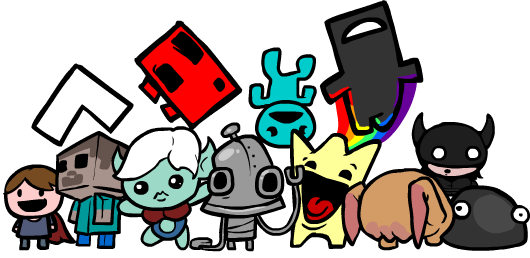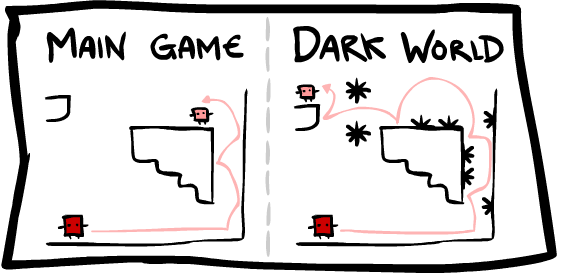Super Meat Boy pt.2
 Wednesday, January 5, 2011 at 2:45PM
Wednesday, January 5, 2011 at 2:45PM Layers On The Core Challenge
The layers in Super Meat Boy's level design are simple, well designed, but not evenly applied. Bandages and warps are optional challenges designed like Mario coins (challenging your platforming prowess), Mario secrets (stressing your exploration skills), or puzzles (testing your ability to problem solve). The biggest difference between bandages and warps is that bandages challenge the player to collect them and survive to the end of the level. Warp zones remove the player from the level altogether. These layers are great for the most part, but I wish each level had a bandage to grab.
It's difficult to even provide examples of my favorite bandages because once you grab them they're removed from the level on latter attempts. In other words, there's no ghost bandage image to remember where it used to be. I would have also liked the remaining levels with bandages marked on the world map in some way. After all, the game indicates when you've collected the bandage(s) in a stage, but not when there's more to grab.
Characters

The only other layer on top of the core level design is the characters. Like Super Mario Crossover, there are some brilliant adaptations of characters into the Meat Boy style. I particularly like how Flywrench, a character that can fly indefinitely in its original game, still maintains flying like mechanics without breaking the wall dependent platforming style of Meat Boy. It's the same with Naija from Aquaria. If you think Meat Boy is a bit too unweildly, then surely there's another character more akin to your style.
While the optional characters do change the way you can navigate through levels, I don't consider their inclusion in the game as a layer of the level design. While some bandaids and warps can only be accessed with some characters, the level challenges aren't designed in this way. In other words, there aren't any distinct powerup locks or alternate paths in the levels designed around specific characters. The game is designed around Meat Boy and the rest of the cast (that largely control like Meat Boy) just plays around in his world. Along those lines, I'm not 100% convinced that all characters can beat all the levels.
Difficulty Design

The difficulty design in Super Meat Boy is good and bad. The good is that on top of just completing a level, players have the option of shoot for low times to earn A+ ratings. In Super Meat Boy there is only A+ or nothing, a simplification of a grading system that I really like (it almost reflects my college career). Earning an A+ usually just requires one to constantly move forward eliminating any unnecessary waits or pauses. Unlike Donkey Kong Country Returns, there isn't a consistent, distinct, and signficant layer of the level designed to open up alternate paths for the speedy, skilled player. Just clean up your standard strategy and you'll do fine.
Earn an A+ for a level and a harder version will be unlocked in the dark world. The dark world takes the same levels, however linear/strict, and makes the challenges even more strict by adding extra enemy elements, removing platforms, or adding switches. I like how you must earn the dark world levels by proving your skills before hand. This is a very Perfect Dark way of guiding the player experience. In general, I have mixed feelings about the dark world levels. Once you A+ the analogous light world level, you generally have most of what it takes to handle the dark world equivalent easily. So for being an extra level, sometimes you don't get that much "extra" (like the dark world in Pictobits). Fortunately, some dark world levels contain bandaids, which do create significantly different challenges.
The light world levels are necessary to beat the game. Everything else is optional. So if you want a harder challenge, you can play the extra levels, warp zone levels, or play as different characters. There's plenty of room to hit your flow zone via modal difficulty.
The bad part about Super Meat Boy's difficulty design stems from the core system and core design philsophy of Team Meat. I'll get to this in part 3. Before I do, I must comment on the variation and aesthetics.
Variation

There are two main types of level challenges in Super Meat Boy, strict and emergent. I use the term emergent here loosely. After all, the entire game is emergent. However, the levels that feature enemy and level elements with interplay, the push-pull emergence creates a very distinct platforming experience. Team Meat does a great job creating a wide variety of both types of challenges throughout the game. With new level and enemy elements every 5 levels or so, there's enough levels to introduce an element then ramp up the difficult and add a twist before moving on. More on specific levels in part 4.
Aesthetics and Story

Visually and thematically, I like the places Meat Boy goes. From the forest to the salt factory to the dystopia city Rapture, you platform through themes that are far removed from the more typical ice/fire/jungle type levels. I love the attention to detail with the light rays especially in the levels with crumbling platforms. I love the retro throwback looks of the warp zones and the modified sound scape. I love all the subtle and not so subtle allusions to other video games from Mario's "your princess is in another castle" to Street Fighter (see image above). Unfortunately, the aesthetic design affects the functional design in a few irksome ways. The tiny nooks in the broken structures are easy to slip into and rather difficult to get out of. Without the small push around solids like in Super Mario Bros., being in a space this restrictive is more frustrating than functional or fun.
As unique as salt is, it's still just one hit kills "lava." The buzz saw is the most basic enemy unit in the game. And because the platforming gameplay is so dependent on walls for a good chunk of the player mechanics, the levels in Super Meat Boy are largely composed of building structures. In other words, get used to buildings with buzz saws.
The story in Super Meat Boy gets props for not using any dialog, text, or voice acting. The ol' Brawl style silent film approach is very appropriate for video games like this. Unfortunately, the animation and detail of the cut scenes are not up to the same level as the game graphics. This isn't so disappointing, but the cut scenes are somewhat incongruous with the gameplay in another way; they're too long. The game moves fast, resets fast, and loads fast. But when we get to a cut scene, most of the cuts are a bit too long. The ideas in these scenes are simple. There's no need to dwell on Meat Boy's expression for that long.
I don't care for the violence and crude humor of Super Meat Boy. But I do find the persistent blood stains that Meat Boy leaves behind very functional. The blood not only marks all the buzz saws you died on, but it marks the walls and floors you touched navigating through the level. The persistent blood definitely qualifies as a highly communicative visual element like the lines in Orbox-B. The stains go a long way in helping players remember their previous attempts and make corrections accordingly.
Part 3 awaits, do you need a pallet cleanser?


Reader Comments